Remove the cable from alternator "B" terminal (A).
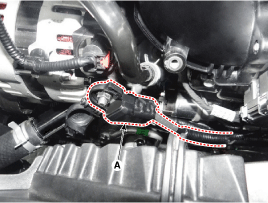
Turn the ignition switch OFF and disconnect the negative (-) battery terminal.
Remove the air cleaner.
(Refer to Engine Mechanical System - "Air Cleaner")
Remove the battery.
(Refer to Engine Electrical System - "Battery")
Remove the cable from alternator "B" terminal (A).

Remove the starter solenoid "B" terminal mounting nut, and then disconnect the starter cable (B) and ST connector (A).
Starter solenoid "B" terminal tightening nut:
9.8 ~ 11.8 N.m (1.0 ~ 1.2 kgf.m, 7.2 ~ 8.7 Ib-ft)
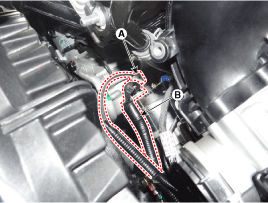
Remove the starter mounting upper bolt (A).
Starter mounting bolt:
42.2 ~ 53.9 N.m (4.3 ~ 5.5 kgf.m, 31.1 ~ 39.8 lb-ft)

Lift the vehicle.
Remove the engine room under cover (A) after loosening the mounting bolts.
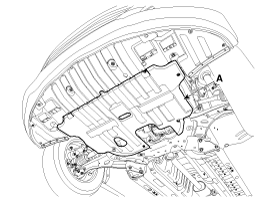
Remove the side cover RH (A) after loosening the mounting bolts.

Using a hexagon wrench, loosen the tensioner (A) by turning it clockwise.
Remove the drive belt (B).
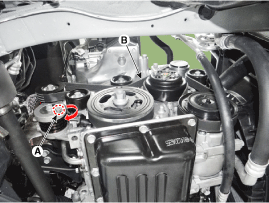
Disconnect the oil pressure switch connector (A).
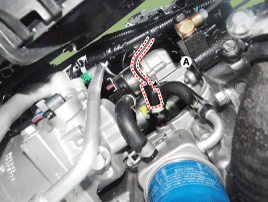
Disconnect the compressor connector, and then by loosening the mounting bolts, widen the gap between the compressor (A) from the engine to remove the starter.
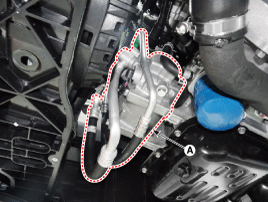
Remove the starter mounting under bolt (A).
Starter mounting bolt:
42.2 ~ 53.9 N.m (4.3 ~ 5.5 kgf.m, 31.1 ~ 39.8 lb-ft)
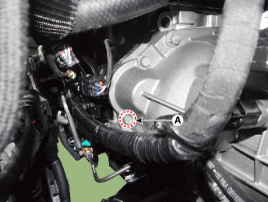
Remove the starter (A).
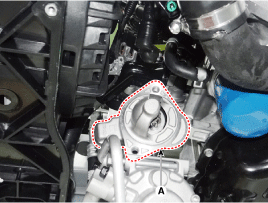
Install in the reverse order of removal.
Disconnect the M-terminal (A) on the magnet switch assembly.
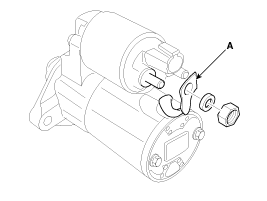
After loosening the screws (A), detach the magnet switch assembly (B).
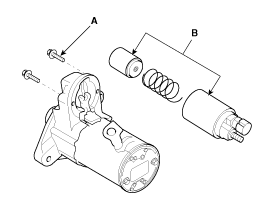
Loosen the through bolts and then remove the brush holder assembly (A), yoke (B) and armature (C).
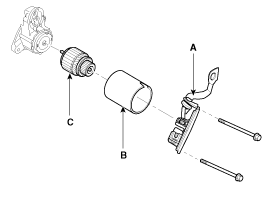
Remove the lever packing (A) and lever plate (B).
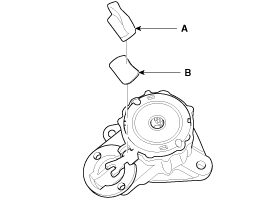
Remove the shield (A) and packing (B).
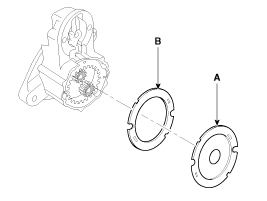
Disconnect the planet gear (A).
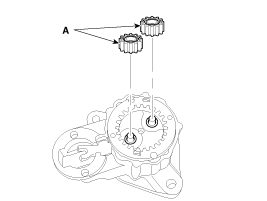
Disconnect the planet shaft assembly (A) and lever (B).
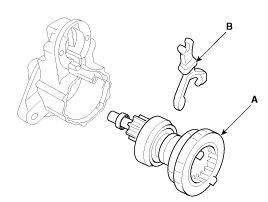
Press the stopper (A) using a socket (B).

Remove the stop ring (A) using stop ring pliers (B).

Disconnect the stopper (A), overrunning clutch (B), internal gear (C) and planet shaft (D).

Using a suitable pulling tool (A), pull the overrunning clutch stopper (C) over the stop ring (B).
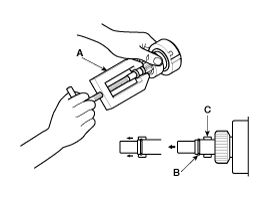
Reassemble in the reverse order of disassembly.
Reassemble in the reverse order of disassembly.
Remove the starter.
Disassemble the starter as shown at the beginning of this procedure.
Inspect the armature for wear or damage from contact with the permanent magnet. If there is wear or damage, replace the armature.
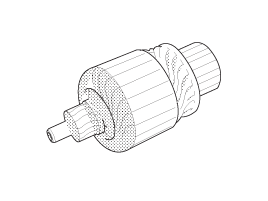
Check the commutator (A) surface. If the surface is dirty or burnt, resurface with emery cloth or a lathe within the following specifications, or recondition with #500 or #600 sandpaper (B).
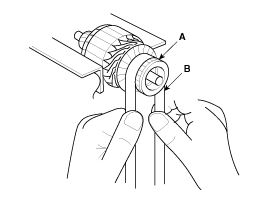
Check the commutator diameter. If the diameter is below the service limit, replace the armature.
Commutator diameter
Standard (New) : 33.0mm (1.2992in.)
Service limit : 32.4mm (1.2756in.)
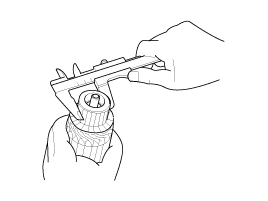
Measure the commutator (A) runout.
If the commutator runout is within the service limit, check the commutator for carbon dust or brass chips between the segments.
If the commutator run out is not within the service limit, replace the armature.
Commutator runout
Standard (New): 0.02mm (0.0008in.), max
Service limit: 0.05mm (0.002in.)

Check the mica depth (A). If the mica is too high (B), undercut the mica with a hacksaw blade to the proper depth. Cut away all the mica (C) between the commutator segments. The undercut should not be too shallow, too narrow, or v-shaped (D).
Commutator mica depth
Standard (New) : 0.5mm (0.0197in.)
Limit : 0.2mm (0.0079in.)
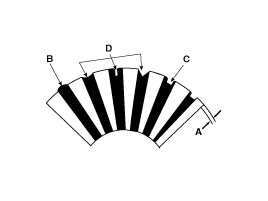
Check for continuity between the segments of the commutator. If an open circuit exists between any segments, replace the armature.
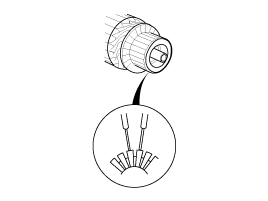
Check with an ohmmeter that no continuity exists between the commutator (A) and armature coil core (B), and between the commutator and armature shaft (C). If continuity exists, replace the armature.
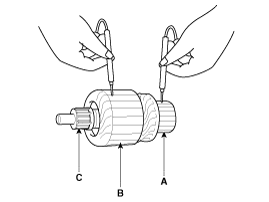
Brushes that are worn out, or oil-soaked, should be replaced.
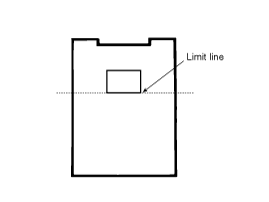
The seat new brushes, slip a strip of #500 or #600 sandpaper, with the grit side up, between the commutator and each brush, and smoothly rotate the armature. The contact surface of the brushes will be sanded to the same contour as the commutator.
Make sure there is no continuity between the (+) brush holder (A) and (-) plate (B). If there is continuity, replace the brush holder assembly.
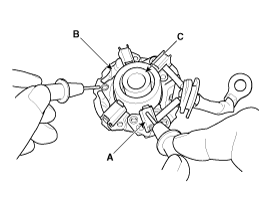
Use a pipe (C) of suitable size for the brushes not to get removed from the brush holder.
Slide the overrunning clutch along the shaft.
Replace if it does not slide smoothly.
Rotate the overrunning clutch both ways Check that it locks in one direction and rotates smoothly in reverse. If it does not lock in either direction or locks in both directions, replace it.
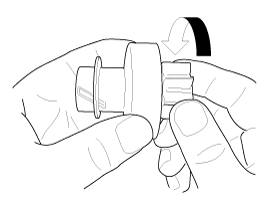
If the starter drive gear is worn or damaged, replace the overrun clutch assembly. (The gear is not available separately.)
Check the condition of the flywheel or torque converter ring gear if the starter drive gear teeth are damaged.
Do not immerse parts in cleaning solvent.
Immersing the yoke assembly and/or armature will damage the insulation. Wipe these parts with a cloth only.
Do not immerse the drive unit in cleaning solvent.
The overrun clutch is pre-lubricated at the factory and solvent will wash away lubrication from the clutch.
The drive unit may be cleaned with a brush moistened with cleaning solvent and wiped dry with a cloth.